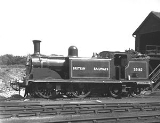
Caledonian Railway 439 Class
Encyclopedia
The Caledonian Railway
439 Class is a class of 0-4-4
T steam locomotive
. It was a development of the earlier 19 Class and 92 Class 0-4-4Ts and predecessor of the 431 Class. The 439 Class was introduced by John F. McIntosh
in 1900 and a modified version was introduced by William Pickersgill
in 1915.
auspices. Seventy-four Class 439s passed into British Railways ownership in 1948 and they were numbered 55159-55236 (with gaps).
The 19 and 92 Classes were originally fitted with condensing apparatus
for use on Glasgow Central Low Level lines. Twenty-four of them passed into British Railways ownership and they were numbered 55119-55146 (with gaps).
. The idea was, presumably, to move the centre of gravity forwards and put more weight on the driving wheels. However, it seems strange to use a large-wheeled 0-4-4T (rather than a small-wheeled 0-6-0T) for banking. The 431 Class was numbered 431–434 by the Caledonian, 15237–15240 by the LMS, and 55237–55240 by British Railways.
In 1925 the LMS introduced their own version of the 439 Class and these were numbered 55260-55269 by British Railways.
In the 431 and LMS classes, the cylinder bore was increased to 18¼" and this increased the tractive effort to 19200 lbf (85,405.9 N).
.
419 is currently undergoing a major overhaul and is temporarily out of service.
Caledonian Railway
The Caledonian Railway was a major Scottish railway company. It was formed in the early 19th century and it was absorbed almost a century later into the London, Midland and Scottish Railway, in the 1923 railway grouping, by means of the Railways Act 1921...
439 Class is a class of 0-4-4
0-4-4
Under the Whyte notation for the classification of steam locomotives, 0-4-4 represents the wheel arrangement of no leading wheels, four powered and coupled driving wheels on two axles, and four trailing wheels on two axles...
T steam locomotive
Steam locomotive
A steam locomotive is a railway locomotive that produces its power through a steam engine. These locomotives are fueled by burning some combustible material, usually coal, wood or oil, to produce steam in a boiler, which drives the steam engine...
. It was a development of the earlier 19 Class and 92 Class 0-4-4Ts and predecessor of the 431 Class. The 439 Class was introduced by John F. McIntosh
John F. McIntosh
John Farquharson McIntosh was a Scottish engineer. He was Chief Mechanical Engineer of the Caledonian Railway from 1895-1914 . He was succeeded by William Pickersgill.-Locomotive designs:*Caledonian Railway 19, 92 and 439 classes 0-4-4T...
in 1900 and a modified version was introduced by William Pickersgill
William Pickersgill
William Pickersgill was born in Nantwich in 1861 and died in Bournemouth on 2 May 1928. He was Chief Mechanical Engineer of the Caledonian Railway from 1914 until Grouping in 1923...
in 1915.
Introduction
Ninety-two engines of the class were built between 1900 and 1925, a few under LMSLondon, Midland and Scottish Railway
The London Midland and Scottish Railway was a British railway company. It was formed on 1 January 1923 under the Railways Act of 1921, which required the grouping of over 120 separate railway companies into just four...
auspices. Seventy-four Class 439s passed into British Railways ownership in 1948 and they were numbered 55159-55236 (with gaps).
Earlier versions
- 19 Class Introduced 1895
- 92 Class Introduced 1897, developed from 29 ClassCaledonian Railway 782 ClassThe Caledonian Railway 782 Class was a class of 0-6-0T steam locomotives designed by John F. McIntosh and introduced in 1896. The 29 Class was apparently similar but fitted with condensing apparatus.-External links:*...
The 19 and 92 Classes were originally fitted with condensing apparatus
Steam locomotive condensing apparatus
A steam locomotive condensing apparatus differs in purpose from the usual closed cycle steam engine condenser, in that its function is primarily either to recover water, or to avoid excessive emissions to the atmosphere, rather than maintaining a vacuum to improve both efficiency and power...
for use on Glasgow Central Low Level lines. Twenty-four of them passed into British Railways ownership and they were numbered 55119-55146 (with gaps).
Later versions
In 1922 Pickersgill introduced the 431 Class with larger cylinders and cast-iron front buffer beam for bankingBank engine
A bank engine or helper engine or pusher engine is a railway locomotive that temporarily assists a train that requires additional power or traction to climb a grade...
. The idea was, presumably, to move the centre of gravity forwards and put more weight on the driving wheels. However, it seems strange to use a large-wheeled 0-4-4T (rather than a small-wheeled 0-6-0T) for banking. The 431 Class was numbered 431–434 by the Caledonian, 15237–15240 by the LMS, and 55237–55240 by British Railways.
In 1925 the LMS introduced their own version of the 439 Class and these were numbered 55260-55269 by British Railways.
In the 431 and LMS classes, the cylinder bore was increased to 18¼" and this increased the tractive effort to 19200 lbf (85,405.9 N).
Preservation
One, CR 419, (later LMS number 15189, BR 55189) has been preserved and is the flagship of the Scottish Railway Preservation SocietyScottish Railway Preservation Society
The Scottish Railway Preservation Society is a charity, whose principal objective is the preservation and advancement of railway heritage in Scotland. The Society was formed in 1961, and it has been actively collecting and displaying railway artifacts of Scottish significance ever since...
.
419 is currently undergoing a major overhaul and is temporarily out of service.
Sources
- Ian Allan ABC of British Railways Locomotives, 1948 edition, part 3, pages 45-46 and 1961 edition, part 3, page 54

